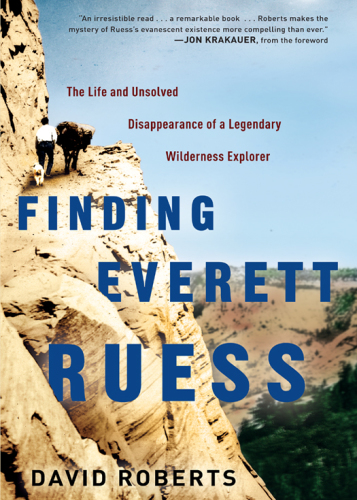
Finding Everett Ruess
The Life and Unsolved Disappearance of a Legendary Wilderness Explorer
کتاب های مرتبط
- اطلاعات
- نقد و بررسی
- دیدگاه کاربران
نقد و بررسی

May 9, 2011
In this exhaustive biography, Roberts (No Shortcuts to the Top) retraces the life and disappearance of Everett Ruess in 1934. A young artist and adventurer, Ruess left home in Los Angeles at 16 and spent most of the following four years traveling alone through the remotest regions of the American West. He chronicled his adventures in letters, journals, and watercolors, and soon after he vanished in the backcountry of southern Utah, a legend grew around the handsome and troubled wanderer. Roberts deftly recounts the development of Ruess's celebrity and the controversies that continue to surround the mystery of his death. As a biographer, Roberts faced a difficult task: Ruess was not well-known in his lifetime, and the extensive gaps in his own accounts of his travels are only sparsely supplemented by the testimonies of those he encountered. This lack of evidence added fuel to the legend, and Roberts spends a great deal of time examining theories about Ruessâespecially the claim that he was both gay and suicidal. Roberts's thoroughness leads to tedium at times, but his approach captures the complexity of his subject.

May 15, 2011
The absorbing story of wilderness explorer Everett Ruess, who has gained a cult-like following since his disappearance in 1934.
In adventure writer Roberts' (The Last of His Kind: The Life and Adventures of Bradford Washburn, America's Boldest Mountaineer, 2010) latest, the author examines the life of Ruess, who was born in 1914 to caring, if over-involved parents. From a young age, he was fascinated with nature. At 16, he set off on the first of his expeditions, hitchhiking from Los Angeles to Carmel, then moving on to Big Sur. Roberts depicts Ruess as intelligent but somewhat naïve, and completely unable to support himself. He became increasingly dependent on his cash-strapped parents to fund his wanderings, and his sense of entitlement deepened over the course of his short life. The author relies on Ruess' surviving letters and journals to paint a portrait of the explorer, and they reveal a moody, pensive and often troubled young man who had a disdain for sedentary life: "I don't think I could ever settle down. I have known too much of the depths of life already, and I would prefer anything to an anticlimax." The second half of the book delves into the possible fate of the explorer, presenting readers with four possible outcomes: suicide, murder, accidental death or withdrawal into hiding. Roberts explores each of these avenues thoroughly, providing both sides of each argument before laying out his own investigation. Though readers may be left with niggling doubts—Roberts chronicles many hoaxes with regards to Ruess' disappearance—in the end, he makes a convincing case.
A well-researched, readable look at a complex personality in wilderness exploration.
(COPYRIGHT (2011) KIRKUS REVIEWS/NIELSEN BUSINESS MEDIA, INC. ALL RIGHTS RESERVED.)

February 15, 2011
In 1930, 16-year-old Everett Ruess set out from California and traveled by horse and burro through Arizona, New Mexico, Utah, and Colorado, maintaining a journal and bartering the exquisite artworks he created for goods. Then, in 1934, he disappeared. A contributing editor to National Geographic with 20 books to his credit, Roberts first probed the enduring mystery of Ruess's disappearance in a 1999 story for the magazine, then again in 2009 when it appeared that Reuss's remains had been found. (False alarm.) Ruess is such an enduring legend in the Southwest that annual "Everett Ruess Days" are held in Escalante, UT; there is even a species of dinosaur, Seitaad ruessi, named after him. Ruess is frequently compared to Christopher McCandless, whose story Jon Krakauer told in Into the Wild; Krakauer wrote the introduction here. An intriguing tale with lots of regional promotion; could break out into something big.
Copyright 2011 Library Journal, LLC Used with permission.

June 1, 2011
Twenty years old when he vanished in southern Utah in 1934, Everett Ruess has become in recent decades a focus of considerable popular and artistic interest. His fate seemed resolved when a desert grave was discovered in 2008, a matter in which Roberts was intensely involved, but DNA analysis excluded the remains as those of Ruess. Nevertheless, anyone intrigued by the Ruess phenomenon will be enthralled with Roberts' review of the young man's biography, the stature of his artistic achievements and unrealized potential, and efforts to find and eventually memorialize him. Likened by critics to a John Muir-in-the-making, Ruess recorded his 1930s rambles in the desert Southwest in diaries, letters, poems, woodcuts, and watercolors. Perceptively noting Ruess' emotional and aesthetic maturation in his body of work, Roberts rues gaps in it caused by materials gone missing, which paradoxically deepen the Ruess mystery. Weighing various theories on his disappearance, Roberts skillfully combines the missing-person story with fair appraisals of Ruess. This is sure to appeal to fans of wilderness wanderers.(Reprinted with permission of Booklist, copyright 2011, American Library Association.)

























دیدگاه کاربران